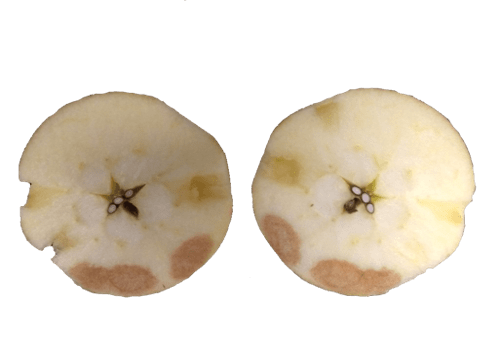Causes and Prevention of Chilling Injury in Honeycrisp Apples
What is chilling injury and how is it expressed in Honeycrisp apples?


Honeycrisp apples are highly susceptible to the development of physiological disorders. Physiological disorders are abnormalities that can occur within different fruit tissues that are not caused by pests or mechanical damage but are commonly caused by several factors such as environmental conditions, genetic background, maturity at harvest, preharvest, and postharvest practices. Honeycrisp fruits are particularly susceptible to the temperature to which they are exposed during storage. When Honeycrisp fruits are stored at a temperature that is too cold (i.e., < 37℉), the fruits are prone to develop the physiological disorder of chilling injury.
Chilling injury in Honeycrisp apples is expressed in two main formats: soft scald and soggy breakdown, both of which lead to a loss of quality, marketability, and profitability, and therefore an increase in fruit loss and waste. Soft Scald symptoms are characterized by a light-dark brown soft sunken discoloration patch on the apple skin (Fig. 1). This discoloration is irregular but has sunken skin and rigid borders. The cuticle of an apple with soft scald is seen to have tears in the wax and dullness. On the other hand, soggy breakdown symptoms occur in deeper layers of the apple, not in the skin. Symptoms of soggy breakdown include soft-brown spongy tissue within the apple flesh (cortex) (Fig. 2). Soggy breakdown is harder to observe in apples since it is within the cortex (anywhere between the cuticle and core) and has no clear warning signs before cutting an apple open (Fig. 3). In severe cases, complete rings of brown flesh tissue can form.
What causes chilling injury in Honeycrisp apples?

Honeycrisp is a chilling-sensitive cultivar, due to its skin and flesh structures containing compounds that are more easily oxidized. Due to this, Honeycrisp fruits cannot be directly stored at lower temperatures than their normal tolerance, which corresponds to 37℉, or they will be prone to develop soft scald and/or soggy breakdown.
Maturity at harvest can also affect the susceptibility of Honeycrisp fruits to chilling injury. It has been reported that fruits that are harvested late in the season, will have a higher incidence of soggy breakdown. Therefore, fruits that are left in the tree waiting for red skin color development have increased susceptibility to develop this disorder during storage.
Large fruits harvested from trees with light crops are also more susceptible to developing the disorder, therefore preharvest management practices are important to decrease the incidence of chilling injury.
Regarding environmental factors, cooler temperatures and excess moisture have also been correlated with an increased soggy breakdown and soft scald incidence. Typically, fruits that are harvested in warmer/wetter climates, such as the Mid-Atlantic, have a higher probability of developing soft scald than those grown in cooler drier climates
When do chilling injuries develop?
Chilling injury symptoms of soft scald and soggy breakdown will develop after the first three months of direct storage of fruits <37°F postharvest. However, it is important to highlight that the symptoms will only become visible after the fruits are taken out of the cold temperatures and transferred to shelf life (temperatures around 68°F).
What are some practices to avoid the development of chilling injuries in Honeycrisp?
Chilling injury development can be prevented or reduced by strategies at the preharvest level, at harvest, and also during postharvest storage.
At the preharvest level, it is important to manage Honeycrisp orchards to avoid light crops, as these are associated with large fruit sizes, which in turn express higher chilling injury incidence. Preharvest management practices such as thinning, pruning, rootstock use, and nutrition, among others, are all important to consider as tools to decrease the development of the disorder postharvest.
Additionally, managing the maturity at harvest is another important consideration to reduce chilling injury. Avoiding harvesting fruits late in the season will reduce soggy breakdown susceptibility. The regulation of fruit maturity through the use of preharvest plant growth regulators that block the gaseous plant hormone ethylene (which plays a key role in controling ripening) can also be an effective alternative to reducing chilling injury. The use of plant growth regulators such as ReTain® (active ingredient: Aminoethoxyvinylglycine (AVG), Valent USA) or Harvista® (active ingredient: 1-Methylcyclopropene (1-MCP), AgroFresh), will delay ripening, extending the harvest window, allowing keeping fruit on the tree for a longer time without it getting overripe. This allows more flexibility during harvesting and overall reduces chilling injury susceptibility by reducing maturity levels in fruit.
Finally, at the postharvest level, the preconditioning of fruits at 50° F for 7 days, previous to storage at 38° F for several months, has been shown to decrease soft scald and soggy breakdown susceptibility. The negative side of this practice is that it can increase the susceptibility of Honeycrisp fruit to the physiological disorder of bitter pit.
This article appears in August 2023, Volume 14, Issue 6 of the Vegetable and Fruit News.
Vegetable & Fruit News, August 2023, Volume 14, Issue 6
Vegetable and Fruit News is a statewide publication for the commercial vegetable and fruit industries and is published monthly during the growing season (April through October). Subscribers will receive an email with the latest edition.
Subscribe